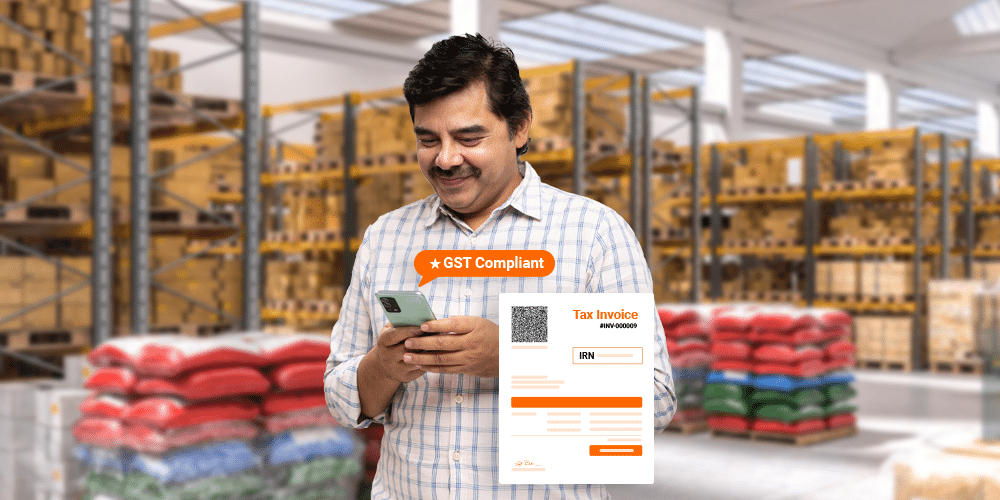A simple and quick guide on e-invoicing for Indian SMBs. Click to explore e-invoicing limit, applicability, exemptions, modes of generation, eligible documents, cancellation, and others.
Is your business now eligible for e-invoicing? Are you confused about the entire e-invoicing process and looking for ways to make yourself well-informed before generating e-invoices? Let me congratulate you for landing on the right page. This page contains the basic but the most important information related to e-invoicing that every small business owner must know. Without further delay, let’s get started.

The e-Invoicing Process
e-Invoicing is a major initiative under the Goods and Services Tax (GST) regime. e-Invoicing involves the process of reporting eligible invoices to the government e-invoice portal and getting them digitally signed. The digitally signed invoice is called an e-invoice and must be used for all other business transactions. The e-invoicing process thus enables a digital record of all eligible transactions, thereby reducing the scope for tax evasion and other malpractices like fake invoices that were prevalent before the introduction of e-invoicing.
From a business perspective, e-invoicing helps with the auto-reporting of invoices into GST returns, auto-generation of e-way bills, reduces disputes among parties involved in a transaction, improves payment cycles, reduces processing costs, and thereby greatly improves overall business efficiency.
Which Businesses Need to Generate e-Invoices
e-Invoicing has been implemented in phases, with the first phase announced in October 2020. Started with businesses having aggregate annual turnover (AATO) greater than or equal to Rs.100 Crore. In a recent announcement, the e-invoice limit was reduced to Rs.5 Crore. If your business turnover exceeds Rs.5 Crores in any previous financial year starting 2017-18, you need to generate e-invoices from 1st August 2023.
Which Businesses Are Exempt from e-Invoicing
Certain businesses are exempt from e-invoicing even when their turnover falls under the eligible criteria. The list includes –
- Entities within Special Economic Zones (SEZs)
- Insurance companies, banks, financial institutions (including non-banking financial companies)
- Goods transport agencies providing road transportation services
- Providers of passenger transportation services
- Service providers offering admission to cinema exhibitions on multiplex screens
Which Transactions Require e-Invoicing
Currently, e-invoices need to be generated only for a few documents, including –
- Invoices
- Credit Notes and
- Debit Notes.
These documents must be between the notified class of taxpayers and registered persons or for export transactions. Only business-to-business (B2B) and export invoices need to be reported to the e-invoice portal. Business-to-consumer (B2C) transactions are currently not covered under e-invoicing.
e-Invoice Generation Process
Generating e-invoices does not mean the government or the government portal will generate e-invoices. It also does not mean businesses should not create normal invoices.
Eligible businesses for e-invoicing must continue to generate normal invoices using their own billing, accounting or ERP systems. Once generated, these invoices need to be reported to the official e-invoice portal, which is called ‘Invoice Registration Portal (IRP)’. This means the data from the normal invoice needs to be entered into the IRP in a specified format (JSON format).
Once entered, the IRP will validate the information and generate an invoice copy with a unique 64-character Invoice Registration Number (IRN), and QR code and sign it digitally. The digitally signed invoice with a unique IRN and QR code is called an e-invoice. An e-invoice is valid only with a valid IR number.
Methods of e-Invoice Generation
Currently, three different modes are available for e-invoice generation, including –
- Excel-based Tool: A free offline tool is provided by the e-invoice portal that helps create and generate e-invoices.
- Direct API Integration: In this method, the taxpayer’s billing, accounting or ERP system directly requests the IRP to generate an IRN, and the IRP returns the same.
- API Integration through GSP: In this method, the taxpayer’s software will send the request for IRN through a GSP (GST Suvida Provider).
How to Cancel an e-Invoice
An e-invoice can be cancelled on the invoice registration portal (IRP) within 24 hours from the time of generation. After 24 hours, there won’t be any provision for cancelling the e-invoice. Also, e-invoices with active e-way bills cannot be cancelled.
Further, amendments or additions to generated e-invoices are also not possible on the e-invoice portal. Any such changes can be made on the GST portal while filing GSTR-1 returns.
Once cancelled, the same invoice number cannot be used to generate a new e-invoice.
Conclusion
Hope this quick guide helps you get a basic understanding of the e-invoicing framework. You might feel a little difficult in the beginning, which is pretty common. Once you get used to the entire process, generating e-invoices becomes part of your everyday business activities. However, for a hassle-free e-invoicing experience, using reliable billing software or an ERP is one of the ideal solutions. Relying on free tools may not help you to achieve business efficiency in terms of e-invoicing. Choose right products, ease your e-invoicing journey.


